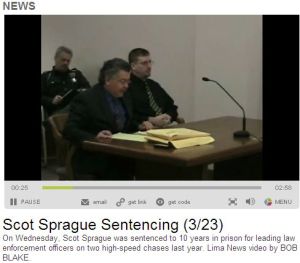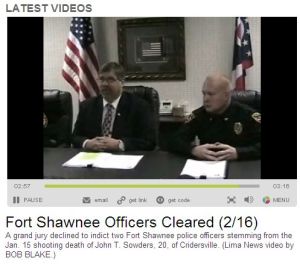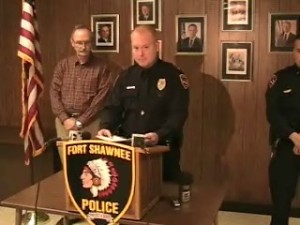LIMA — Two weeks into the new year and already there’s been one jury trial in Allen County Common Pleas Court. A glance at the court docket reveals the prospect that several high-profile cases may come before juries before the year is finished.
Those realities and Hollywood’s portrayal of crime and punishment seem to make criminal trials by jury the rule in the criminal justice system. Those in the legal profession, however, say trials are the exception.
One way courts, prosecutors and public defenders attempt to manage their cumbersome dockets is through negotiations, better known as plea deals.
“Let me tell you up front that I absolutely despise negotiating pleas. Philosophically, I don’t like it at all,” said Allen County Prosecutor Juergen Waldick. “However, given 400 and some cases a year, it is just fiscally and logistically impossible not to resolve cases. I consider it to be just an unavoidable, necessary evil.”
Statistics compiled by the Ohio Supreme Court on an annual basis demonstrate just how many felony cases make their way to the state’s common pleas courts every year. In 2009, the courts handled more than 112,000 cases. There was some sort of resolution to more than 88,000 of those.
How many cases go to trial?
In a purely statistical sense, very few of the felony-level cases that enter Ohio’s judicial system end in any sort of trial. The Ohio Supreme Court’s annual Ohio Courts Statistical Report shows that, of the 88,570 cases that came to a resolution in 2009, only 2,606 were by way of a trial.
The sheer volume of cases makes it nearly impossible for courts to have trials for every case, according to Bryan Ward, a law professor and director of clinical programs at Ohio Northern University.
“The reality is that it’s never explicitly said that prosecutors are going to offer deals and defendants are going to accept deals because of the costs involved in a trial. The reality is they have a docket they have to administer on a daily basis with resources that are very limited in terms of number of judges, number of prosecutors, number of public defenders,” Ward said.
“I would venture a guess that in larger jurisdictions if you were to say you had to try 50 percent of the cases, they physically couldn’t do it — maybe not even 25 percent — just because of the large number of cases before the court every day.”
Across the region, despite resolutions in more than 2,200 cases in 2009, there were only 37 trials. Allen County led the way with 11 trials. Mercer County didn’t have any.
Even looking as far back as 1999, the first year the report was made available electronically on the Ohio Supreme Court’s website, there is little change in the overall trend. In that year, 65,382 of the 83,230 cases that came into the system statewide found some sort of resolution. However, only 2,407 of those ended with a trial.
Changing perceptions of plea deals
Legal practitioners acknowledge the system would bog down if prosecutors and defenders lacked the ability to negotiate cases.
“If the commissioners and the public say we want to pay for three or four more judges and more prosecutors, then if that’s what they want to get every case tried,” said Judge Richard Warren, one of two Allen County Common Pleas Court judges. “Otherwise, it’s a practical impossibility. That’s the reason we have to go through the litany we just talked about.”
The sheer cost of adding additional judges, prosecutors, defenders and other legal staff makes trying all felony criminal cases cost-prohibitive. That doesn’t mean the system promotes plea bargaining as a means to clear a docket.
“We’ll do what we have to do. As a judge, we have to make sure we don’t try to twist arms and say, ‘Hey, you have to do something to get this off my docket,’” said Judge Jeffrey Reed, also an Allen County Common Pleas Court judge. “We give the attorneys opportunities to come up here and see if there’s anything they can do to resolve the case. Generally, if they meet enough times and give an honest look at the case, there’s usually some kind of proposal to resolve the case.”
ONU’s Ward said plea bargaining wasn’t always seen as an acceptable way to move cases through the system.
“The Supreme Court, through a series of cases in the 1800s, concluded that plea deals as we know them today would probably not be admissible in court under the view that it really was a confession of guilt, of paying through a promise of a benefit,” Ward said. “It raised questions about whether or not you could rely on it, so it was improperly induced or motivated.”
Ward said it wasn’t until the 1970s that the Supreme Court fully embraced plea deals. At that time, the court recognized with crime rates rising and a full system that it was impractical not to embrace plea deals, he said.
How plea deals work
Generally, the attorneys working on a criminal case have an idea in advance how the court will perceive any potential deal before it’s presented. That gives prosecutors and defense attorneys an idea of what options are likely on the table as well as what a judge is likely to accept.
There are some instances where negotiations and plea deals won’t be offered, Waldick said. When negotiations are a part of the equation, there are factors used in making agreements, he said.
“We look at what kind of a case it is. We’re results-oriented. What is it that we want out of this?” Waldick said. “We have two judges in this jurisdiction, so we have some idea of what kind of sentences the judges are going to impose in certain cases. With that in mind, I try to resolve it close to what I think a judge will do at trial.”
Stephen Chamberlain, a Lima attorney and public defender, said negotiations from the defense perspective are all about minimizing a client’s exposure to potential prison time or hefty fines.
“What people don’t understand is that most clients, when they are confronted with the evidence, will understand the predicament they’re in and will accept a reasonable offer in exchange for their admission of guilt. That’s how most of these cases get resolved,” Chamberlain said. “If there are factual disputes or things like that, that is what the trial is there for. Ultimately, the client has to make the decision. I never force, and no attorney I know forces, a client to take a plea.”
Even if a prosecutor and a defense attorney come to an agreement, Ohio law typically doesn’t commit a judge to accepting it.
“At the end of the day, we have the final say,” Warren said.
Both judges admitted, however, that they try to be consistent in accepting negotiations based on similar deals in the past.
“You want to make sure the whole system is handled consistently,” Reed said.
A client’s right
No one involved in the system denies that trials are expensive. Plea deals, while still costly, do save money. Knowing exactly how much money they save, however, is difficult to say.
State organizations like the Ohio State Bar Association, the Ohio Prosecuting Attorneys Association and the Ohio Supreme Court don’t track the cost savings. Local officials say it’s difficult to track, given funding streams that come from the state, the county and various offices involved in investigations.
All are in agreement, however, that cost isn’t the final arbiter in deciding whether cases proceed to trial. “You can’t put a price tag on justice,” Warren said. “It’s just what our system dictates.”
Caseload, budgets and all other factors pale in comparison to one — a client’s constitutionally protected right to trial — in deciding whether a deal is accepted, Chamberlain said.
“It’s their right. That’s what I always emphasize to my clients,” Chamberlain said. “If you want a full trial, that is your absolute right. Nobody can stop you from having it. I can’t stop it as a defense attorney, the prosecutor can’t stop them, the judge can’t stop them.”
Published in The Lima News: Jan. 16, 2011



